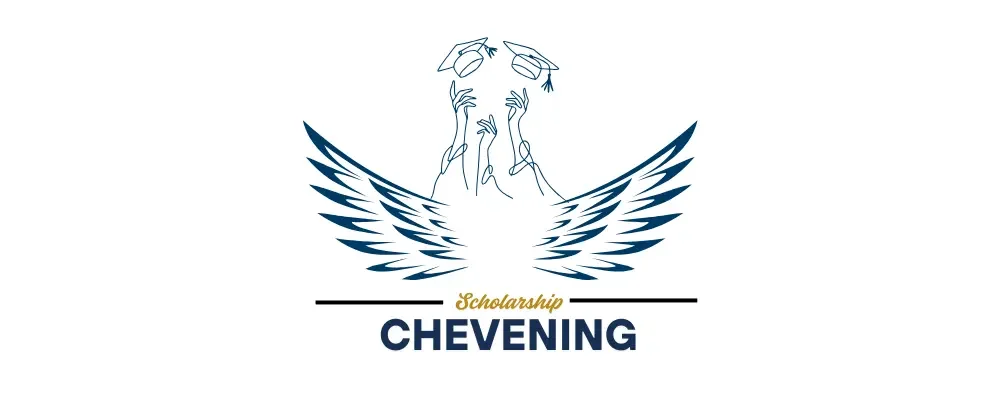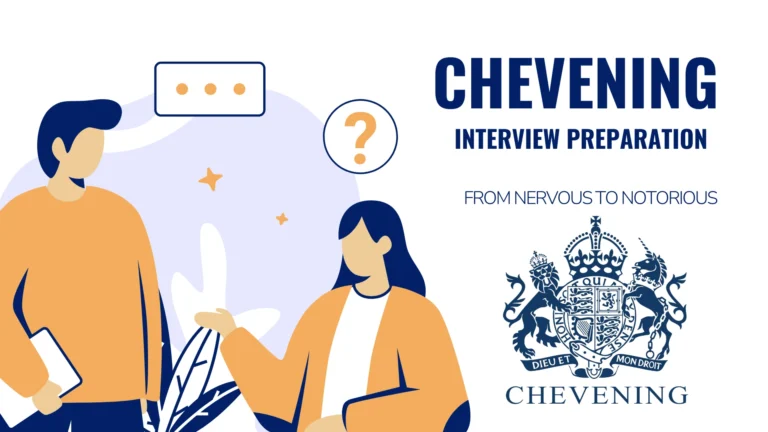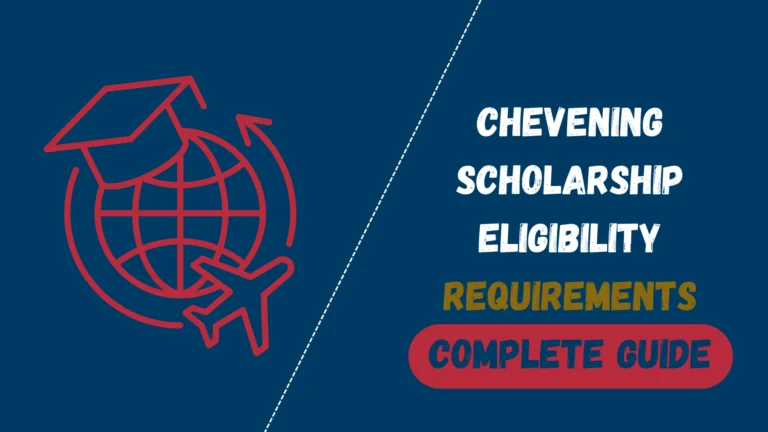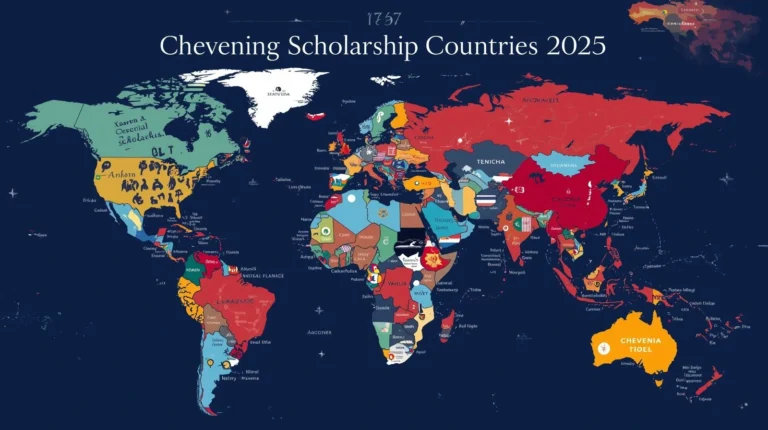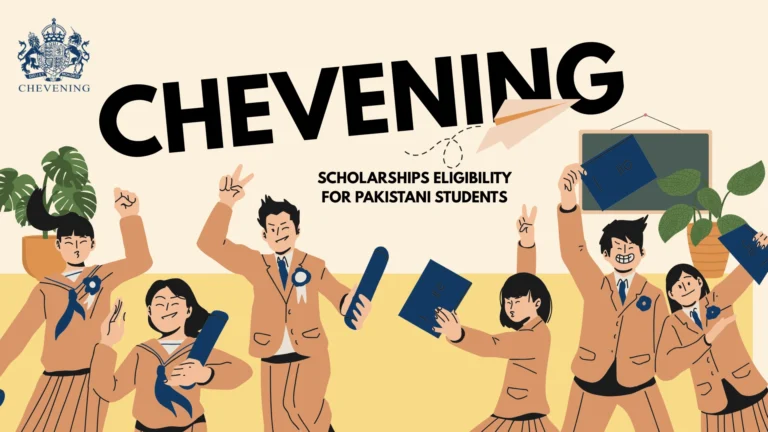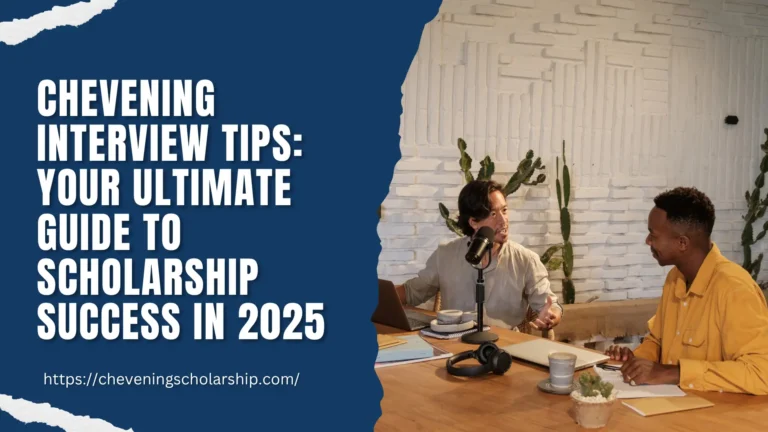Chevening Selection Process: Your Complete Guide to Landing the UK’s Most Prestigious Scholarship
Picture this: You’re sitting in front of your laptop, palms slightly sweaty, about to submit your Chevening scholarship application. You’ve spent weeks—maybe months—perfecting your essays, and now you’re wondering: What happens next?
I get it. The Chevening selection process can feel like navigating a labyrinth blindfolded. But here’s the thing—it doesn’t have to be mysterious. After diving deep into how Chevening scholars are actually selected, I’m going to walk you through every stage of this journey, from the moment you hit “submit” to the day you (hopefully) receive that golden offer letter.
And trust me, understanding this process isn’t just about satisfying your curiosity. It’s about giving yourself a genuine competitive edge.
What Makes the Chevening Selection Process Different?
Let me be straight with you: Chevening isn’t your average scholarship program.
While most scholarships look at your grades and call it a day, the Chevening selection criteria dig deeper. They’re hunting for future leaders, changemakers, and people who’ll actually make a difference when they return home. It’s not about being perfect on paper—it’s about demonstrating potential that goes beyond your transcript.
The selection process is rigorous, sure, but it’s also surprisingly transparent once you know what you’re looking for. Around 1,500 scholarships are awarded each year from over 70,000 applications globally. Those aren’t lottery odds—they’re competitive odds, which means preparation and understanding the system actually matter.
Breaking Down the Chevening Selection Timeline
Time is everything in this process, so let’s get the Chevening selection process timeline crystal clear.
The journey typically unfolds like this:
August-November: Application window opens and closes (usually early November)
January-February: Longlisting happens—this is when independent readers review applications
February-March: If you make the shortlist, you’ll receive your Chevening interview invite
March-June: Interviews are conducted at British embassies or high commissions
June-July: Conditional offers are sent out (yes, this waiting period is brutal)
August onwards: Final offers confirmed once you meet all conditions
Here’s what most people don’t realize: The Chevening selection timeline isn’t just about dates—it’s about understanding that each stage has its own evaluation criteria. You’re not competing against the same metrics throughout. What gets you longlisted might differ from what gets you selected at the interview stage.
Stage One: How Chevening Applications Are Scored
Let’s talk about something most applicants obsess over: Chevening application scoring.
Your application goes through independent assessment by trained readers who’ve never met you and don’t know your name. They’re looking at your essays through a specific lens, scoring against four key pillars:
- Leadership and influence
- Networking abilities
- Course suitability and career plan
- Personal statement and UK connection
Each essay isn’t just read—it’s scored. And here’s the kicker: Generic responses tank your scores faster than anything else. The readers can spot copy-paste inspiration from successful essays a mile away.
I’ve noticed a pattern with successful applications: They tell stories. Not fabricated ones, obviously, but genuine narratives that demonstrate impact rather than just listing achievements. Instead of saying “I led a team of 15,” successful applicants explain how they navigated a specific challenge, what they learned, and what changed as a result.
Pro tip: The Chevening scholarship longlist is determined purely by your written application. No interviews, no external factors—just your words. Make them count.
The Moment of Truth: Chevening Shortlisting Process
Making it to the shortlist? That’s your first major victory.
The Chevening shortlisting process happens after independent assessment. If your application scores highly enough, you move from the longlist to the shortlist. This is when you’ll receive that nerve-wracking email: your Chevening interview invite.
Let me share something important here—receiving an interview invitation doesn’t mean you’re guaranteed a scholarship, but it does mean you’ve already outperformed roughly 90% of applicants. You should feel proud of that.
What Happens When You Receive an Interview Invitation?
When that Chevening interview scheduling email lands in your inbox, you’ll typically have some flexibility in choosing your interview date. Most interviews happen between March and June, though this varies by country.
Here’s what you need to do immediately:
- Respond promptly (within 48 hours is ideal)
- Check the location—usually at the British embassy or high commission in your country
- Note the format—most are in-person, but some regions conduct virtual interviews
- Start preparing seriously (more on this in a moment)
The Chevening interview scheduling process is generally smooth, but if you have legitimate conflicts, communicate early. They’re reasonable people who understand life happens.
Cracking the Code: The Chevening Interview Process
Right, let’s address the elephant in the room: the Chevening interview.
This is where things get real. Your written application got you here, but the interview determines whether you’re getting that scholarship.
Who’s on the Chevening Interview Panel?
The Chevening interview panel typically consists of 2-3 people, often including:
- A British embassy or high commission representative
- Chevening alumni
- Sometimes, local academics or business leaders
They’re not there to grill you mercilessly. Honestly, they want you to succeed—they’re looking for reasons to say “yes,” not reasons to reject you. But they also have a job to do: assessing whether you truly embody the Chevening values.
The Chevening Interview Duration and Structure
Most Chevening interviews last between 20-30 minutes, though some stretch to 45 minutes. Don’t let the brevity fool you—it’s intense.
The structure usually follows this pattern:
Opening (2-3 minutes): Brief introductions and settling in
Core questions (15-20 minutes): Deep dive into your application, leadership experience, networking plans, and career goals
Your questions (3-5 minutes): Your chance to ask thoughtful questions
Closing (1-2 minutes): Thank yous and next steps explanation
Common Chevening Interview Questions (The Real Ones)
Let’s talk about Chevening interview questions that actually come up, not the sanitized versions you find everywhere.
On Leadership:
- “Tell us about a time when your leadership didn’t go as planned. What happened?”
- “How do you handle team members who disagree with your decisions?”
- “Give us an example of how you’ve influenced policy or practice in your organization.”
On Networking:
- “How will you build your professional network in the UK?”
- “Who are three people you’d most like to meet during your scholarship year, and why?”
- “Describe your most valuable professional relationship and how you maintain it.”
On Your Future:
- “Where do you see yourself in five years, and how does Chevening fit into that?”
- “What specific changes do you plan to make in your country upon return?”
- “How will you stay connected to the UK and Chevening network after your scholarship?”
The Curveball Questions:
- “If you don’t receive Chevening, what’s your plan B?”
- “Tell us about a failure that taught you something valuable.”
- “How do you deal with stress and pressure?”
Notice a pattern? They’re asking for specifics, stories, and genuine reflections—not rehearsed elevator pitches.
How to Prepare for Chevening Interview (Without Losing Your Mind)
Look, I know you’re Googling “how to prepare for Chevening interview” at 2 AM. We’ve all been there.
Here’s my honest Chevening interview preparation checklist:
Six Weeks Before:
✓ Review your application thoroughly—they have it in front of them ✓ Research your proposed universities and courses deeply ✓ Read recent UK-your country bilateral news and developments ✓ Identify 3-5 core stories that demonstrate your leadership, networking, and impact ✓ Start following UK current affairs, especially in your field
Two Weeks Before:
✓ Practice answering questions out loud (yes, actually speak them) ✓ Prepare thoughtful questions to ask the panel ✓ Research who might be on your interview panel ✓ Do mock interviews with friends or mentors ✓ Prepare your outfit (business formal, culturally appropriate)
The Day Before:
✓ Review your essays one final time ✓ Prepare your documents (passport, certificates, references) ✓ Plan your route to the interview location ✓ Get proper sleep (seriously, don’t underestimate this)
Interview Day:
✓ Arrive 20 minutes early ✓ Bring water (dry mouth is real) ✓ Turn off your phone completely ✓ Take three deep breaths before entering ✓ Remember: They want you to succeed
Top Chevening Interview Tips That Actually Work
After talking to dozens of successful scholars, here are the Chevening interview tips that consistently make a difference:
1. The STAR Technique Is Your Friend
Structure your answers: Situation, Task, Action, Result. It keeps you focused and prevents rambling.
2. Authenticity Beats Perfection
The panel can spot rehearsed, robotic answers. If you need a moment to think, take it. Saying “That’s a great question, let me think for a moment” shows reflection, not weakness.
3. Connect Everything Back to Your Country
This scholarship is fundamentally about what you’ll do when you return. Every answer should somehow tie back to your impact at home.
4. Prepare for the “Why This University?” Deep Dive
They will ask why you chose your specific courses and universities. “It’s a top-ranked university” isn’t enough. Know the professors, research centers, specific modules, and how they align with your goals.
5. Have Real Questions Ready
Asking “When will results be announced?” is weak. Try: “How do current Chevening scholars typically structure their networking activities during the academic year?” or “What advice would you give to scholars about maximizing their UK experience?”
6. Mind Your Body Language
Make eye contact with all panel members, not just the person asking questions. Sit up straight but not rigidly. Use hand gestures naturally when explaining complex ideas.
7. The Follow-Up Question Test
If your answer prompts follow-up questions, that’s usually good—it means you’ve sparked their interest. Don’t panic; engage deeper.
Understanding Chevening Interview Scoring Criteria
Here’s something most candidates never learn: how interviews are scored in the Chevening selection process.
Panel members typically evaluate you across several dimensions:
| Criteria | What They’re Assessing | Weight |
|---|---|---|
| Leadership Potential | Evidence of influence, vision, and ability to inspire others | High |
| Communication Skills | Clarity, confidence, persuasiveness | High |
| Cultural Awareness | Understanding of UK, global perspective, diplomatic sensitivity | Medium |
| Academic Readiness | Clear study plan, knowledge of chosen courses | Medium |
| Networking Intent | Concrete plans for building professional relationships | High |
| Return Commitment | Genuine plans to apply learning in home country | High |
| Authenticity | Genuine responses vs. rehearsed answers | High |
The Chevening interview scoring isn’t about getting everything perfect. It’s about demonstrating you’re someone who’ll make the most of this opportunity and create meaningful change afterward.
After the Interview: What Happens Next?
You’ve finished your interview, and now you’re in the worst part: waiting.
Chevening Interview Follow Up—Should You?
Here’s the honest answer: A brief, professional thank-you email is appropriate, but don’t expect a response. Send it within 24 hours, keep it under 100 words, and don’t try to add information you forgot during the interview.
Keep it simple: “Dear [Panel],
Thank you for the opportunity to interview for the Chevening Scholarship yesterday. I appreciated our discussion about [specific topic] and remain enthusiastic about the prospect of studying [your course] in the UK.
Best regards, [Your Name]”
That’s it. Don’t overthink it.
Understanding Chevening Interview Outcomes
Chevening interview results typically arrive 2-4 months after your interview. Yes, that wait is excruciating.
There are three possible outcomes:
1. Conditional Offer This is the goal. You’ve been selected, pending you meet specific conditions (usually university offers and English language requirements).
2. Reserve List You’re good enough, but funding ran out. The Chevening scholarship reserve list means if selected candidates decline or don’t meet conditions, you might move up. It happens more often than you’d think.
3. Unsuccessful It’s not the end of the world, though it feels like it initially. Many successful scholars were rejected in previous years before winning the scholarship.
The Chevening Conditional Offer Process
Got a conditional offer? First off—congratulations! But don’t celebrate too hard yet; you’ve still got work to do.
The Chevening conditional offer criteria typically include:
- University offers: You need unconditional offers from at least one of your three chosen universities
- English language: Usually IELTS 6.5 overall (no section below 6.0) or equivalent
- Graduation certificate: If you haven’t graduated yet, you’ll need proof when you do
- Work experience verification: Sometimes they’ll verify your employment claims
- Medical clearance: Basic health checks
You’ll usually have until June/July to meet these conditions. The conditional offer process involves submitting proof of each requirement through the online portal.
What Is Conditional Offer in Chevening Selection?
Think of it like a job offer contingent on background checks. Chevening is saying “We want you, but you need to prove you can actually study in the UK.” It’s their way of managing risk—they’re investing £30,000+ in you, after all.
How Final Candidates Are Selected
The Chevening final candidate selection happens after all conditions are verified. This is typically in July or August.
Once you’ve met everything:
- Your offer becomes unconditional
- You receive detailed instructions about pre-departure briefings
- Chevening arranges your flights and initial accommodation
- You’re officially a Chevening scholar
The Chevening final selection list is published on the website (usually just first names and countries to protect privacy), and you’ll receive your official scholarship agreement to sign.
Real Talk: Chevening Scholarship Rejection—What Now?
Let’s address this because it’s important: Chevening scholarship rejection happens to exceptional people every year.
The common reasons for being rejected from Chevening include:
- Generic, non-specific applications that could apply to anyone
- Weak demonstration of leadership impact
- Unclear or unrealistic career plans
- Poor interview performance despite strong applications
- Insufficient connection between chosen courses and career goals
- Lack of genuine commitment to returning home
But here’s the thing: Many scholars were rejected once, sometimes twice, before succeeding. JK Rowling was rejected by 12 publishers. Your Chevening rejection doesn’t define your worth or potential.
What to Do If You’re Rejected:
- Request feedback (they don’t always provide it, but ask)
- Strengthen your weak areas honestly
- Gain more leadership experience
- Apply again next year if still eligible
- Explore other scholarships (Rhodes, Marshall, Commonwealth, Fulbright)
Insider Insights: Real Chevening Interview Experience
I reached out to several scholars to get their Chevening interview experience, and here’s what stood out:
Amara from Nigeria: “I was terrified, but the panel was warm and genuinely interested in my work. They asked unexpected questions about Nigerian politics that I hadn’t prepared for, but staying authentic and admitting when I didn’t know something helped more than bluffing.”
Carlos from Colombia: “The interview felt like a conversation, not an interrogation. They pushed back on my answers sometimes, which threw me initially, but I realized they wanted to see how I think under pressure.”
Mei from Malaysia: “I’d prepared 20 stories, but they only asked about three. What mattered was going deep into those examples rather than having superficial answers to everything.”
Special Considerations for 2025 Selection
If you’re eyeing the Chevening scholarship 2025 selection, here’s what you should know:
The process remains largely consistent, but recent trends show:
- Increased emphasis on climate change and sustainability leadership
- Greater focus on digital innovation and tech for development
- More questions about post-pandemic recovery strategies
- Stronger scrutiny of genuine commitment to return home
The Chevening interview questions 2025 will likely probe deeper into:
- Your understanding of current UK-home country relations
- How you’ll navigate studying abroad post-pandemic
- Your plans for remote networking if needed
- Concrete examples of leading through crisis or uncertainty
Final Preparation: Your Chevening Interview Preparation Guide
Let’s consolidate everything into a practical Chevening interview preparation guide:
Mental Preparation:
- Visualize success, but prepare for tough questions
- Practice mindfulness or breathing exercises for interview day
- Remember: The panel wants to award scholarships, not reject people
Content Preparation:
- Know your application inside out
- Research UK current events in your field
- Prepare 5-7 strong examples covering different competencies
- Understand your universities’ specific offerings
Logistical Preparation:
- Scout the interview location beforehand if possible
- Prepare professional attire that makes you feel confident
- Bring backup copies of all documents
- Plan to arrive very early (traffic, nerves, finding the room)
Questions to Ask:
- “What do you find most rewarding about working with Chevening scholars?”
- “Are there particular skills or experiences that successful scholars tend to develop during their year?”
- “How can scholars best contribute to UK-[your country] relations?”
The Real Secret to Chevening Selection Success
After all this information, here’s the truth I wish someone had told me earlier:
The Chevening selection process isn’t about being the perfect candidate. It’s about being the most authentic version of yourself while demonstrating genuine leadership potential and commitment to positive change.
The scholars who succeed aren’t necessarily the ones with the highest GPAs or the most impressive job titles. They’re the ones who can articulate a clear vision, demonstrate real impact, and convince a panel that investing in them will create ripples of positive change in their communities.

Your Next Steps
So where do you go from here?
If you haven’t applied yet: Start working on your application with these selection criteria in mind. Remember, the Chevening scholarship acceptance deadline for applications is typically early November.
If you’re waiting for interview results: Use this time productively. Apply for your university courses, work on your English language test if needed, and keep building your leadership experience.
If you’ve been shortlisted: Take the interview preparation seriously, but don’t let anxiety paralyze you. You’ve already proven you’re exceptional—now just show them who you really are.
If you’ve been rejected: Learn from it, grow from it, and consider applying again. Some of the most impactful Chevening scholars faced rejection before their acceptance.
Conclusion: Your Chevening Journey Starts Here
The Chevening selection process is rigorous, competitive, and sometimes frustrating. But it’s also fair, transparent, and ultimately rewarding for those who invest the time to understand it properly.
You now know more about how Chevening scholars are selected than 90% of applicants. You understand the timeline, the scoring, the interview process, and what really matters to the panel.
The question isn’t whether you’re good enough for Chevening—it’s whether you’re willing to put in the work to present your best self through this process.
Remember: Every current Chevening scholar was once exactly where you are now, wondering if they had what it takes. They did. You might too.
Now stop reading articles and start preparing your application or interview. Your future self will thank you.
Have you been through the Chevening selection process? What was your experience? Share your insights in the comments below—future applicants will appreciate your wisdom.
Ready to take the next step? Visit the official Chevening website to start your application or check your eligibility. Your leadership journey awaits.
Good luck. You’ve got this.
